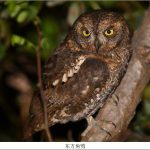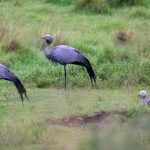
Sultanpur National Park is situated approximately 30km to the west of Indhira Gandhi International Airport in New Delhi, India. It is in Haryana State and comprises over 300 acres of lake, woodland and scrub. The park is managed for the benefit of the wildlife and made accessible for visitors with a footpath along the lakeshore and out onto spits that allow a closer approach to the heronry. It is a must-visit for any birder spending any time in New Delhi.
Whilst many communal nesting birds (including cormorants, herons and ibis) use the rookery, the most obvious and spectacular are the Painted Storks, Mycteria leucocephala.
The storks begin to arrive from August and will usually be sitting on eggs by October. There can be quite a gap between the early birds and the late brooders. Helpless chicks in the nest and free-flying juveniles were present during my visit at the beginning of December. The frequency of birds carrying nesting materials suggested that some of the structures needed shoring up as the chicks got bigger and heavier.
It is possible that some birds were attempting a second brood after losing their first. There are a lot of predators drawn to such abundance with Eurasian Marsh Harriers and Greater Spotted Eagles known to take chicks from the heronry. Eggs often fall victim to the ubiquitous House Crow.
The predators have plenty of opportunities beyond the heronry with countless ducks, waders and galliformes. Thus a reasonable percentage of the chicks make it through to fledging. A study conducted at Sultanpur (Abdul Jamil Urfi, Thangarasu Meganathan and Abdul Kalam) between 2003 and 2005 noted that the the clutch size was bigger in early nests. It was thought that later nests with smaller clutches were either replacement clutches from a failed nest or from low-quality breeders.
The study also noted a correlation between the monsoon water levels and the number of nests. It was difficult to estimate the number of storks as they disperse into the surrounding areas to feed and the numbers have swollen since the study and the heronry has expanded across a number of islands.
Though it is designated as a National Park, it is more commonly known as Sultanpur Bird Sanctuary. There are mammals, with Nilgai antelope being the most obvious. Less often seen are Blackbuck and Jungle Cat. The birds however, are the main attraction with 314 claimed by various eBird contributors.
Knowledgable guides can be hired at the entrance gate for walks or for guided buggy rides. The Park is open from 07.00 ’til 16.30, but be aware that it is closed on Tuesdays and during the monsoon.


















Great Photos!! We ran into several Nilgau Antelope last year, while birding our way thru South Padre Island, in Texas.